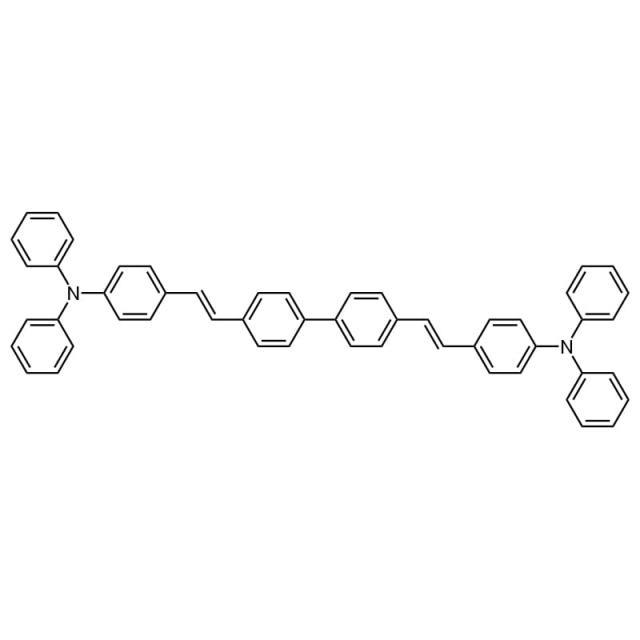The content on our website is provided solely for general informational purposes. It should not be considered, nor is it intended to provide advice or recommendations for the purchase, sale, or trade of any products or services. Importantly, the information presented does not constitute an offer to sell or a solicitation of an offer to buy any product.
Please be aware that the availability of our products may vary across different markets due to regulatory restrictions or other considerations. Consequently, not all products or services may be available in your region or country. For specific inquiries regarding the availability and pricing of any product, please contact us at sales@noctiluca.eu.
General information
-
Name:
BDAVBi
-
Full name:
4,4′-Bis[4-(diphenylamino)styryl]biphenyl
-
CAS number:
523977-57-3
-
Chemical formula:
C52H40N2
-
Molecular weight:
692.89 g/mol
-
Absorption:
λmax = 399 nm in THF
-
Photoluminescence:
λmax = 466 nm in THF
-
HOMO/LUMO:
N/A
-
Synonyms:
4,4'-[[1,1'-Biphenyl]-4,4'-diyldi-(1E)-2,1-ethenediyl]bis[N,N-diphenylbenzenamine], N,N-Diphenyl-4-[2-[4-[4-[2-[4-(N-phenylanilino)phenyl]ethenyl]phenyl]phenyl]ethenyl]aniline
-
Classification:
Organic light-emitting diodes, Emmiting layer materials (EML), Blue fluorescent dopant materials
-
Purity:
Sublimed: >99.5% (HPLC)
-
Melting point:
196 °C, TGA: >360 °C (0.5% weight loss)
-
Appearance:
Yellow powder/crystals
BDAVBi Specification: The Advanced Material in Organic Light-Emitting Diodes (OLEDs)
The ever-advancing field of organic light-emitting diodes (OLEDs) is sustained by a myriad of materials and compounds. Among these, BDAVBi—fully known as 4,4′-Bis[4-(diphenylamino)styryl]biphenyl—stands as a crucial component in the OLED technology stack.
Understanding BDAVBi
BDAVBi is an organic compound characterized by its unique molecular structure. This compound has a biphenyl core with two styryl groups substituted with diphenylamino moieties (electron-donating groups) at the para position of each phenyl ring. This compound holds particular significance in the sphere of organic electronic devices, including OLEDs. With a purity of sublimed >99.5% (HPLC), it is a material of the highest quality.
Key Features of BDAVBi
- Emitting Layer Material (EML): BDAVBi serves as an excellent material for the emitting layers in OLEDs. Its unique molecular structure allows for efficient light emission, making it a prime choice for blue fluorescent dopant materials.
- Blue Fluorescent Dopant Materials: BDAVBi’s unique properties make it an ideal choice as a blue fluorescent dopant material. This is particularly beneficial for OLEDs that require high-efficiency blue light emission.
- High Purity: With a purity level of sublimed >99.5% (HPLC), BDAVBi ensures that OLEDs operate with optimal efficiency and longevity. The high purity also minimizes the risk of material degradation over time.
The Role of BDAVBi in Contemporary OLEDs
In the current landscape of OLED technology, the quest for materials that offer elevated efficiency, durability, and reduced energy consumption is relentless. BDAVBi, with its multifaceted properties, aligns seamlessly with these prerequisites. Its role as an emitting layer material ensures not only optimal light emission but also an extended lifespan for OLEDs.
Conclusion
The OLED sector is in a constant state of flux, propelled by the need for materials that are both efficient and durable. BDAVBi, endowed with a unique set of properties and functionalities, is poised to play a significant role in shaping the future of OLED technology. As research progresses and technology matures, BDAVBi is anticipated to find a widening array of applications in organic electronic devices.
